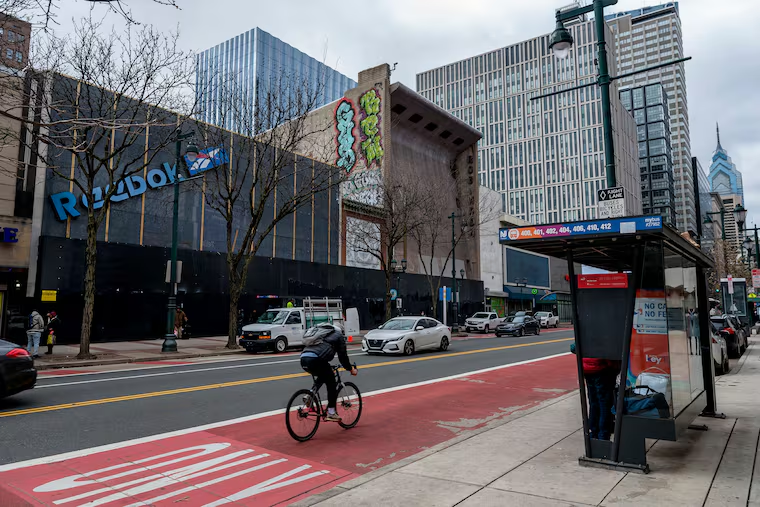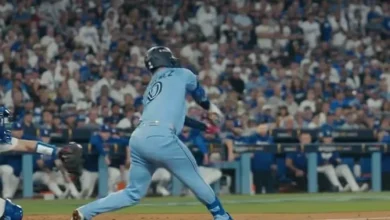With proposed demolitions, a reinvention plan for Market Street is off to a rocky start

The long-awaited effort to reinvent Market East began in the same bombshell manner as the Sixers’ arena proposal did three years ago — with no transparency and no planning.
First, the two new BFFs of the Philadelphia sports world — the Sixers and Comcast — blindsided Mayor Cherelle L. Parker (and the rest of us) by announcing that they intended to raze several buildings on the 1000 block of Market Street, an area covering half the block. As for what they would put in their place, well, they’ll get back to us on that.
This has to be the worst idea for fixing Market Street’s woes since the last bad idea: the Sixers basketball arena.
It’s not just that the Sixers-Comcast development venture has no firm plans to build on the cleared site. Or, that they would be destroying an important and eye-catching design by Victor Gruen, the mid-century architect credited with inventing the American shopping mall. Or, that they would be establishing the third vacant lot on Market Street in the short stretch between Eighth and 13th Streets, the absolute last thing that tattered corridor needs.
We’ve heard nothing from Parker about this rogue move. But shortly after news of the demolitions broke, she announced that her Market East advisory commission would finally hold its first meeting — 10 months after the arena deal collapsed.
The problem was, she neglected to say who will sit on that commission. That will have to wait until Friday, when the mayor is expected to hold a news conference. (Note to the Parker administration: Announcing the membership of an important public commission is supposed to precede the first meeting of said commission.)
Maybe the procedural lapse wouldn’t be so troubling if we hadn’t just endured a two-year ordeal in which the Sixers’ billionaire owners and the mayor paid lip service to community engagement while they tried to ram the arena down the city’s throat.
This time, the Parker administration must ensure that the communities adjacent to Market Street feel heard. And not just those neighborhoods. All Philadelphians have a stake in what happens on the city’s Main Street.
More empty lots won’t help
Having the Sixers-Comcast venture take unilateral action now taints the whole process. According to Jacklin Rhoads, the spokesperson for the partnership, the group believes that getting rid of the buildings will improve the look of the street and increase foot traffic. They say they want to activate the empty lot during next summer’s 250th birthday celebrations, perhaps with a pop-up soccer pitch or beer garden.
The notion that an empty lot helps increase foot traffic is bizarre.
For evidence, look no farther than the two existing asphalt voids on Market Street: the infamous Disney Hole at Eighth Street (so-named for a stillborn Disney theme park) and the Rappaport Estate property at 13th Street. The two lots, both now used for parking, have been sucking the life out of Market Street for 45 and 31 years, respectively.
It’s true that the threatened buildings do not look their best right now. They’ve been unused for years, thanks to poor decisions by their former owner, PREIT, the company that owned the Fashion District before declaring bankruptcy in 2023.
But it wouldn’t take much to make them more presentable during next year’s Semiquincentennial. How about engaging artists to create murals or, better yet, an interactive installation for the festivities?
Although the Sixers-Comcast partnership has hired an architect, Gensler, and started noodling around with some ideas for constructing a residential building, the odds of quickly replacing the existing buildings are slim. High interest rates and rising construction costs brought on, in part, by President Donald Trump’s tariffs have made it almost impossible for developers to break even.
As a result, four high-rise projects in Philadelphia have recently been paused, leaving big holes in the ground: a Pearl Properties tower on 19th Street, the Durst Organization project on Delaware Avenue, the Wendy’s site at 11th and Walnut, and the Jewelers Row tower.
So why rush into the creation of another pit that could sit around for years? Three Philadelphia advocacy groups — the Design Advocacy Group, Preservation Alliance, and Docomomo — have all issued strong statements calling on the developers to reconsider the demolitions.
Reincorporate the old with the new
In an older city like Philadelphia, every existing building, no matter its appearance, is an expression of hope and possibility. It can always be reborn as something new. Clearing these buildings would be the death of that hope.
No one expects that the structures would be reused in their entirety. But that doesn’t mean elements can’t be incorporated into a new development when the Sixers and Comcast are ready to build. The facade of the former Robinson department store — a dramatic, cresting wave covered in sparkly tiles — would look great as the base of a new tower.
Designed by Gruen in 1946 on the body of an older building, the facade is a great example of the sophisticated European modernism brought to America by architects fleeing the Nazis. The enormous, solid surface was intended as a theatrical backdrop for Robinson’s stylish logo, and it could just as easily serve the same function for the next occupant of the site.
Although less special, the art deco building at the corner of 10th Street, is also attractive, especially its corner entrance.
Since the mayor’s advisory commission isn’t expected to have a plan for Market East for about a year — well before construction on a tower can possibly get started — why not just wait?
Given the declining demand for offices and stores, it seems likely the commission will recommend measures to make Market Street more residential. That could involve narrowing the wide thoroughfare, adding bike lanes and landscaping or a park. The plan will almost certainly recommend tax incentives, which would also influence the designs.
Unlike the successful East Market project on the 1100 block, which stretches from Market to Chestnut, the Sixers-Comcast property is quite shallow, which complicates its redevelopment.
However, the site does back up onto the Philadelphia Parking Authority’s Ludlow Street garage.
That structure, which is in poor condition, was supposed to be demolished in the spring and replaced with a modern garage that could support an apartment building. But in response to the changing situation on Market Street, the Philadelphia Parking Authority decided to put that construction “on hold,” director Rich Lazer told me.
Rather than build the garage separately, it would make more sense to collaborate with the Sixers-Comcast team. Construction would be easier, and the developers could turn Ludlow into a pedestrian-friendly street, similar to the ones that crisscross the 1100 block. Nothing has been finalized, though.
Think beyond Market Street
What this example shows is that city planners need to think well beyond Market Street. As I’ve argued before, you can’t fix the problems of the old retail corridor without reckoning with the neglect that is slowly killing the entire commercial district on the east side of Broad Street.
In the 10 months since the arena deal collapsed, a lot has happened. After two years of chaos, Philadelphia’s roving intercity bus station will be right back where it started in the one-story bunker on Filbert Street, immediately north of Market Street. This time, the station will be operated by the PPA, which promises to freshen up the exterior, install new restrooms and air-conditioning, and add landscaping.
While that’s a good decision in the short term, Philadelphia still deserves a full-service bus station worthy of a big city, on par with those in Boston, San Francisco, and Washington, D.C. Although the renderings for the former Greyhound station show an airy waiting room, the reality is that the squat building has all the charm of an auto shop office. It’s barely big enough to accommodate all the bus riders on busy days.
On the day that plans for the bus station were announced, the Preservation Alliance and Docomomo were holding a symposium to explore six design proposals for reusing the former Police Headquarters on Seventh Street, two blocks north of Market Street. Several proposals recommended using the building for a new bus station.
While that’s a nonstarter now, the symposium was a reminder of the city’s failures to address the problems of the greater Market East area. The Police Headquarters, aka the Roundhouse, was designed by Robert Geddes and August Komendant in 1962 to be the anchor for a massive redevelopment. Several blocks of small commercial buildings, hotels and theaters were demolished. Yet most of the cleared land remains a sea of parking today.
The Preservation Alliance invited the Parker administration to send a representative to the symposium, which demonstrated how the Roundhouse could be turned into a community anchor, but no one from the city came, according to Alliance director Paul Steinke.
The administration has also rejected an effort to list the city-owned building on its historic register, despite a consensus among architectural historians that it is internationally significant.
The failure to send a city representative to the symposium is a sign of a closed mind. We’ll never fix the problems facing the greater Market East neighborhood unless the city starts listening to new ideas.





